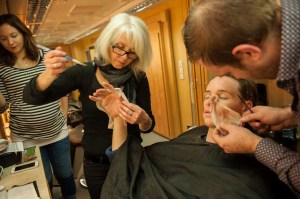
In James Marsh’s The Theory of Everything, the life of theoretical physicist Stephen Hawking is examined from his boyhood until the recent past, covering over a quarter century. The makeup for the actors in the film had to reflect this time span, additionally dealing with the transformation that Hawking (Eddie Redmayne) goes through, since he suffers from a debilitating physical disease that left his mind intact but his body almost entirely crippled.
The makeup artist, Jan Sewell, joined the project through a connection to other crew members at the film’s London hub. “It was Steven Noble the costume designer who got asked to do the project first and recommended me to James,” said Sewell. “I knew it was going to be amazing. I did as much prep as I could and did reference on Stephen Hawking. I made Redmayne up on Les Miserables. When I went to see James Marsh for the first time, I had done quite a lot of prep. He thought I did the right thing and offered me the film fairly quickly. We shot all of it in London except for exteriors and different halls in Cambridge.”
Prior to the nine-week shoot, Sewell had four weeks of prep. “You end up doing the research and would start gearing up again,” she said. “Many of the characters had to age through the whole film. David Thewlis and Harry Lloyd went through the 25 years. The women, such as Maxine Peake came in much later. I had to get wigs made on my days off and prep for her. It was a busy film and very challenging and rewarding.”
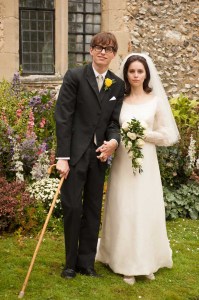
Since Redmayne is on screen for nearly every shot in the film, much of Sewell’s focus was on getting the Hawking character depicted as accurately as possible. “What was really important for me was I needed to lock down Eddie’s makeup before I thought about designing the rest of the film,” Sewell stated. “I suggested an early makeup test. We needed to know how far to go if the director or Eric Fellner at Working Title wanted me to make it really strong, pull back a bit, looking for the essence of a person.”
Redmayne reported for work early in the process to collaborate with Sewell on the various stages of Hawking’s appearance. “I got Eddie cast, got the prosthetics on the way, and got the wigs started,” said Sewell. “In the test, we pretty well got his look first go. All of the tweaks after that were about the way Eddie was sitting in the wheelchair, with prosthetics on his face. He was twisting his body, using different muscles, and I didn’t want the prosthetics getting in the way.”
Kristyan Mallett, an artist with whom Sewell has worked before, supervised Redmayne’s prosthetics. “Kristyan knows that I like subtlety,” Sewell said. “I apply prosthetics as well, but for the two days that we shot with them, I got him to come and we put them on together. We talked about scale. I got him to make earlobes and ear pieces so that we could change the scale of Eddie’s face as the illness gripped him. The bigger ears made his head look smaller. I wanted his whole head to have a disproportionate shape.”
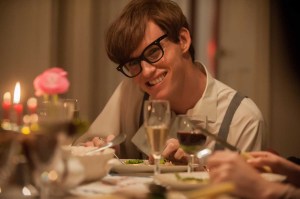 To add to the more extreme stages of Redmayne’s appearance, Chris Lyons and Fangs FX made cheek plumpers for the actor and false teeth, longer at one side and shorter at the other to give the impression that one side of Hawking’s jaw was dropping. Alex Rouse made all the film’s wigs based on Sewell’s concepts.
To add to the more extreme stages of Redmayne’s appearance, Chris Lyons and Fangs FX made cheek plumpers for the actor and false teeth, longer at one side and shorter at the other to give the impression that one side of Hawking’s jaw was dropping. Alex Rouse made all the film’s wigs based on Sewell’s concepts.
“I designed three wigs,” she said. “I used Eddie’s own side and back of his hair. It’s tricky to make wigs look real if they don’t comb into the actor’s own hair. The second wig was more conventional with a part, for the middle segment of his life. The last wig was made over a head-shave, attached with silicone inside of it, and Eddie’s hair clipped out of the way. The wig went over top of the head-shave, slightly deforming the shape of Eddie’s head. Then I put in teeth that pulled down his mouth.”
To complete the most extreme impression of Hawking, Redmayne worked closely with Alex Reynolds, the movement coach on The Theory of Everything. “I had a prosthetic shoulder piece and knees,” she said. “Eddie lost loads of weight. I was able to shave his cheekbones and pull them out. He would move his mouth into certain shapes along with the mouthpieces. The filmmakers allowed me to get Eddie to that point and bring their experience.”
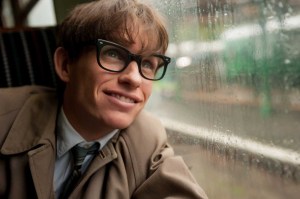 Through principal photography, Sewell solely attended to Redmayne every day of shooting except for the two days when prosthetics were added to his face and hands to make his knuckles and finger joints look more prominent. For scenes in which Hawking is in a wheelchair going to see the Queen, and other scenes at the film’s climax, Redmayne wore full prosthetics. “His nose down the side of his mouth,” Sewell described. “Old-age stipple under his eyes. Prosthetic ears to help the scale, and prosthetic hands and head-shave and mouth pieces. I stuck on earlobes – a slow process making his ears starting to look bigger. Otherwise, it was makeup and highlighting. Slowly, I took the color out of his skin. His lips start to go a little redder. Most of it was done with subtle prosthetics.”
Through principal photography, Sewell solely attended to Redmayne every day of shooting except for the two days when prosthetics were added to his face and hands to make his knuckles and finger joints look more prominent. For scenes in which Hawking is in a wheelchair going to see the Queen, and other scenes at the film’s climax, Redmayne wore full prosthetics. “His nose down the side of his mouth,” Sewell described. “Old-age stipple under his eyes. Prosthetic ears to help the scale, and prosthetic hands and head-shave and mouth pieces. I stuck on earlobes – a slow process making his ears starting to look bigger. Otherwise, it was makeup and highlighting. Slowly, I took the color out of his skin. His lips start to go a little redder. Most of it was done with subtle prosthetics.”
Speaking to the makeup’s subtlety, Sewell stressed her goals of invisibility in Redmayne’s different stages. “If you can see the makeup, I’ve failed,” she said. “Eddie wanted to be able to use muscles. At the end, he could only talk twitching a little eye muscle. I didn’t want to stop him doing that. That was always the idea – it had to be super subtle.”
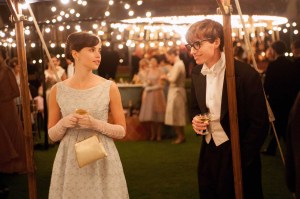 Not only was the film about the physical deterioration of its main character, the film spans several time periods for its other main characters, chief among them Hawking’s wife, Jane Hawking (Felicity Jones). “The approach with Felicity was slightly different,” said Sewell. “I used her as my way of going through the different time zones. I aged her much more subtly. The real Jane Hawking is still very beautiful.”
Not only was the film about the physical deterioration of its main character, the film spans several time periods for its other main characters, chief among them Hawking’s wife, Jane Hawking (Felicity Jones). “The approach with Felicity was slightly different,” said Sewell. “I used her as my way of going through the different time zones. I aged her much more subtly. The real Jane Hawking is still very beautiful.”
For Jones’ looks, Sewell faced two challenges: prosthetics did not work and Jones does not like wearing wigs. “I did all the hair changes with hairpieces,” Sewell noted. “We put on a slightly longer back piece and old-age stipple under her eyes. These were very much based on pictures of the real Jane. Felicity is such a beautiful woman.”
To create various looks for Jones at important points in the Hawkings’ lives, Sewell executed several tests of hairstyles. “We did a very simple Audrey Hepburn look,” said Sewell. “The front of her hair was her own hair. Trying to get across Cambridge in the ’60s.”
For bigger days of the shoot, supporting artists were added to The Theory of Everything’s makeup and hairstyling team. “We had some big makeup calls,” Sewell said. “We did three nights shoots to get the May Ball right. We had extras all the way through and had to get across hair being long or short. In the 60s, everybody had neat little haircuts. Girls plucked their eyebrows away in the ’70s. I used quite a lot of wigs on my supporting artists, subtly done in the background. In addition to me, there was my main artist Leslie Smith who made up Felicity. I had a trainee, Barbara Taylor, who was crowd supervisor, and she would pull in between two and 20 makeup artists for a ballroom scene. There were lots of logistics to work out.”
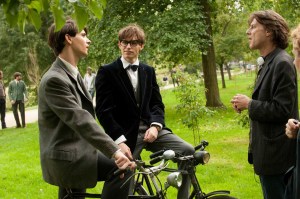
Sewell knew exactly what makeup stage every scene would entail based on the film’s locations. “I do a breakdown for exactly what wig Redmayne had on and what makeup I did for each period,” Sewell described. “You take continuity photographs the whole time. Eddie was aware of where he was at every stage of the illness. We would discuss it and look at the continuity photos. It was very much tracking with my continuity timeline and Eddie’s input to subtly change things.”
Despite being a well-organized shoot, The Theory of Everything’s schedule was based on logistical requirements, necessitating regular adjustments in the characters’ makeup. “Some days, he was in three different looks,” Sewell stated. “Start off young, be old, and then become middle age. He knew exactly where he was. Alex Reynolds, the movement coach, was always aware of what body shape he would be. Eddie has got a great relationship with James Marsh who is directing him every day.”
Though Sewell is a longtime makeup veteran, The Theory of Everything represented new challenges and approaches. “I’ve been doing makeup for over 30 years and I still love it as much now as when I first started,” she said. “I love working with people and love being pushed. I love learning every day. You see a film’s character in front of you, and you can see days you need to push it a bit more.”
Sewell feels positively about The Theory of Everything and what she achieved on screen. “I think it’s probably the best thing I have done,” she said. “The collaboration between all of the other departments — there’s no egos. The sensitivity of the project comes from James. It stands out for lots of reasons being something I’m most proud of. It was a wonderful journey I took with Eddie. On the next project, I’m working with Eddie and want to do early tests with him again. He’s so committed.”





